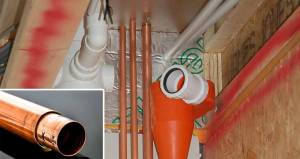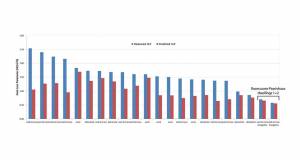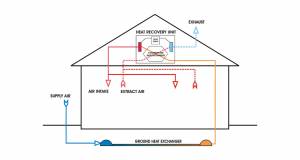Directive Enquiries

In the aftermath of our recent awareness raising, Construct Ireland began to research what measures the Irish government was taking to prepare for the Energy directive, and how this compared with views from other EU member states, an investigation that is revealing startling results. Jeff Colley reports.The imminent introduction of mandatory energy auditing and labelling for buildings through the EU Directive on the Energy Performance of Buildings has been a hobbyhorse of Construct Ireland for some time now, and our efforts to broaden public and industry awareness has resulted in extensive coverage across the national media.
Construct Ireland believes that heightened public awareness on the implications of the directive will help consumers to make informed purchasing decisions, and to realise that investment in thermally efficient building will serve them will in the long run, in terms of value and running costs. The fact that an estimated 83,000 new houses will have been added to the housing stock this year only reinforces the fact that awareness is crucial, to ensure both that consumers demand better performing buildings, and that the construction industry addresses energy performance as an integral concern.
In the aftermath of our recent awareness raising, Construct Ireland began to research what measures the Irish government was taking to prepare for the directive, and how this compared with views from other EU member states, an investigation that is revealing startling results. Jeff Colley reports.
The EU Directive on the Energy Performance of Buildings (EPBD) comes broadly into effect from January 4 th 2006. One of the main discussion points of the directive is that it will introduce mandatory energy labelling on a scale of A to G for properties of virtually every description. Article 7 of the directive requires that “ when buildings are constructed, sold or rented out, an energy performance certificate is made available to the owner or by the owner to the prospective buyer or tenant” .
In light of this, it may seem a little strange that, until recently, so little has been widely known about the directive, just over a year before it comes into effect. A statement by a spokesperson for Martin Cullen, then Minister for the Environment, echoed the government view that “the EPBD explicitly allows additional time […] up to 4th January 2009-to give practical effect to certain complex provisions [such as] provisions relating to the energy performance certification of all newly constructed buildings, and existing buildings, when let or sold”. This would appear to be evident from reading Article 15.2 of the directive, which stresses that “M ember States may, because of lack of qualified and/or accredited experts, have an additional period of three years to apply fully the provisions of Articles 7, 8 and 9”.
An explanation of where such a derogation may be sought is given by David Strong, Managing Director of the Environment section of the UK's BRE, and Chair of the Directive Implementation Advisory Group (DIAG), who is heavily involved in implementing the directive in the UK.
“The directive allows for Member States to delay certain aspects, such as certification and plant inspection, for a maximum of three years, but only if they can demonstrate that there are an insufficient number of suitably qualified experts to undertake those activities. So the onus of responsibility will be on Member States.” Strong states. “I sit on the article 14 committee as an advisor to the European Commission, and they've made it crystal clear that they will take infraction proceedings against Member States that do not comply, and will take a very dim view of Member States who can't provide demonstrable proof—who haven't used all reasonable endeavours to get their experts in place on time to do the building certification”.
Although the Irish Government may be preparing itself, should it fail to implement in full the requirements of Articles 7, 8 and 9 by January 2006, to prove to the EU that these tasks were not achievable in the given time period, the areas that Ireland and other member states are entitled to seek a derogation for may not be as clear as the aforementioned Government view perhaps suggests. Article 7 relates both to general energy performance certification at point of sale or rental, and to energy certificates being displayed in buildings over 1000m2 and “used by the public”, whereas articles 8 and 9 relate to inspection of boilers and air conditioning systems. However, although the directive may allow Member States an additional three years “to apply fully the provisions” of these articles, this does not necessarily mean that introducing and policing energy standards can be withheld for this period.
“One important point that is beginning to dawn on a lot of us, and particularly the UK Government, is that although the certification of buildings and plant inspection issues could be delayed for a maximum of 3 years, the directive does call for minimum energy performance standards to be set and measured from 4 th January 2006”, Strong asserts. “From that date, every Member State is going to have to have in place the national methodology which will measure compliance”.
As a requirement stipulated in Article 15 of the directive, Member States are bound to “ bring into force the laws, regulations and administrative provisions necessary to comply” by 2006. To fulfil this requirement, Member States must adopt a methodology for calculating energy performance at national or regional level, ensure that minimum energy performance requirements based on this methodology are set, and ensure that new buildings meet these standards.
“Any new building submitted for planning or building regulations consent after 4 th January 2006 will need to be checked against the national methodology”, Strong reveals. “If Ireland hasn't got one, it will be in breach, [as will also be the case] if it hasn't got a sufficient number of suitably qualified independent assessors –and you may not need to have very many—to check new buildings submitted for planning consent after 4 th January 2006. Although Ireland and other countries may choose to delay for instance supplying energy certification to existing buildings for some time, they can't delay in essence the requirements with regard to new buildings. The penny is only starting to drop on that for a lot of people”.
This revelation suggests implications that Ireland may not be ready to deal with. Could it even mean that people looking at a property after this period must be given the building's energy certificate? On this point, Strong's response is vehement. “Absolutely. From day one there is no option to delay, because it's a proof of compliance issue at that point in time. Every Member State has to introduce minimum energy performance standards, and the way those standards are measured has to be using the new national method which takes into account methodology,” he states.
“All buildings submitted for planning and building controls from 4 th January 2006 will have to comply with articles 1-6 of the directive in every respect, including having their energy performance assessed using a national methodology, which has to be compliant with Annex 1 of the directive,” Strong stresses. “Anyone looking to buy or rent a property submitted for planning or building controls after this date will have to be presented with an energy rating”.
In order to prepare a plan for Irish implementation, an interdepartmental working group comprising of officials and experts drawn from the Department of the Environment, Heritage and Local Government, the Department of Communications, Marine and Natural Resources, and Sustainable Energy Ireland has been established. According to a Department of the Environment spokesperson, “it is planned to complete the Plan, submit it to Ministers for approval, and publish it for public/industry comment, by end 2004”, with recent reports revising this to a January 2005 publication date. “That implies that no aspects of the directive are going to be implemented on time”, stresses Strong. “It sounds odd that Ireland are proposing to delay consultation on the changes for some time. Consultation of industry and public by the end of 2004 is far too late to have any elements in place by the proposed start date, if that is the case. If the government are sending those sorts of signals out it certainly doesn't suggest any great sense of urgency.”
As Kevin O'Rourke, Head of Built Environment at Sustainable Energy Ireland revealed in Issue 6 Volume 2 of Construct Ireland, the European Standards Body, CEN, is preparing a programme of standards relating to assessing the energy performance of buildings which Member States may apply. Speaking generically of Member States, O'Rourke stressed “at this point, they are waiting for CEN to deliver, and the picture should be clearer by the end of the year”.

However, given the importance of complying with the directive as the 2006 deadline fast approaches, Strong believes there is too little time for Member States to wait for CEN to deliver. “They'd best not hold their breaths, because it's extremely unlikely that CEN are going to produce a workable methodology in time. What will have to happen over the next 18 months is for each Member State to produce a methodology that can be applied from that date. CEN are working on this as well but there are no guarantees that CEN will have the principal building blocks for a suitable national methodology by then”, he states. “The general view, [which is also] held in the UK, is that we cannot afford to wait for CEN. If in due course CEN provide those building blocks it will be helpful, but what the UK is doing so as to be compliant with the directive from 4 th January 2006 is getting on and developing methodologies both for housing and for non-domestic buildings which will enable the UK to comply with the directive's requirements from 4 th January 2006.
“What it will also mean of course is that from 4 th January 2006 there will have to be a sufficient number of independent experts properly trained and qualified in the use of any national methodology who can then use that methodology for assessment of new buildings to check compliance and to verify compliance with building regulations requirements.
“It does sound odd that Ireland appear to be adopting a position where they feel that as far as certain key provisions of the directive are concerned—in particular the adoption of a national methodology for new buildings and buildings undergoing major renovation from 4 th January 2006—they seem to be implying that that is something they could delay for up to 3 years. It's certainly not the view that is being taken within the UK. It's as a consequence of that that the UK government have come out recently with a major consultation document , the recommendations of which are likely to be adopted in October or November. This will then allow at least a year to ensure that the UK is in a position to implement the main elements from 4 th January 2006”.
Indeed, the UK government are bringing in related measures such as mandatory A or B bandings for boilers, reflecting a commitment to implement the directive on time, and a recognition that early implementation could have commercial advantages.
The UK Government's view is reflected in many other EU Member states, such as in Denmark, which adopted an energy labelling scheme based on the “Act to promote energy and water savings in buildings” in 1996. According to Jens Laustsen of the Danish Energy Authority, “we are trying here in Denmark to implement the directive fully by 4 th January 2006”. This commitment, Laustsen reveals, is seen as an opportunity by many leading Danish construction companies who “expect that implementing this directive could give a good market advantage for the countries going ahead.
“Some of the companies expect to get high sales of products across Europe,” he adds. “Instead of saying how long can we wait, maybe we can have an advantage by going fast and being in the front wave”.
Whilst there may be advantages to implementing the directive quickly, the consequences of prolonging action could have broader political and economic ramifications. “For member states who are slow to come on board, the consequences fall into a number of different categories,” Strong reveals. “First of all, because buildings are such a key component in most northern hemisphere countries of their Kyoto obligations, they will find it difficult to deliver on Kyoto unless we see dramatic improvement in the energy performance of buildings. From a national policy perspective, the directive is an incredibly effective weapon in that armoury. If the extension to 2009 is sought, they're not going to reap the full benefits of the time scale.
“All the evidence points to the fact that much of the directive is merely promoting the uptake of measures that are cost effective now. What will happen is, because of buildings' long life, Member States that delay will end up with a legacy of buildings which could have been better, which maybe will be there for fifty years or more”. This view is echoed by Laustsen. “If you go on building new buildings”, he considers, “and you wait another 3 years for implementing the inspection of buildings, you will lose those buildings for the next fifty years, and you will have a higher energy consumption in those buildings for a long time because you've wasted the chance to get a higher energy performance.”
Indeed, aside from the effects the directive will have on how buildings are constructed in the future, owners of existing buildings will also be affected, which could drastically alter the commercial property sector.
“Some of the negative propaganda put out by certain sections of the UK property industry has been major scare mongering that this could write billions of pounds off the value of commercial property,” stresses Strong. “The reality is that there will be winners and losers in this equation. It could also introduce a whole new dynamic into the commercial property sector because there may well be buildings which might well be viewed by some as stranded assets or distressed sales, where for instance a tenant who has any consideration for their reputation regarding corporate social responsibility or brand equity is not going to want to be seen dead renting a poorly performing building in energy terms. It's a real reputation management issue.
“The actual certification of those buildings by a competent person becomes a very key issue, because if you can write off millions of pounds off the value of a building by getting the rating wrong, then you had better be backed up by pretty good insurance”, he continues.
- energy directive
- building performance
- european union
- EPBD
- david strong
- energy consumption
- heat recovery
- ratings
Related items
-
 BEAM launch new app for easy MVHR control
BEAM launch new app for easy MVHR control -
 Learn about wastewater heat recovery remotely
Learn about wastewater heat recovery remotely -
 We need better building performance metrics
We need better building performance metrics -
 Circular economy plans come into focus
Circular economy plans come into focus -
 Bridging the building performance gap
Bridging the building performance gap -
 Flynn HRV appoints new design engineer
Flynn HRV appoints new design engineer -
 Passive house district uses one-third the heat of typical apartments — report
Passive house district uses one-third the heat of typical apartments — report -
 Simple and stunning Highlands passive house merges old and new
Simple and stunning Highlands passive house merges old and new -
 Exclusive: UK may deliver EU sustainable building targets in spite of Brexit – while Scotland & Wales commit
Exclusive: UK may deliver EU sustainable building targets in spite of Brexit – while Scotland & Wales commit -
 Lunos low energy ventilation units pick up awards
Lunos low energy ventilation units pick up awards -
EU president sets passive precedent
-
 Have energy ratings become an afterthought?
Have energy ratings become an afterthought?

